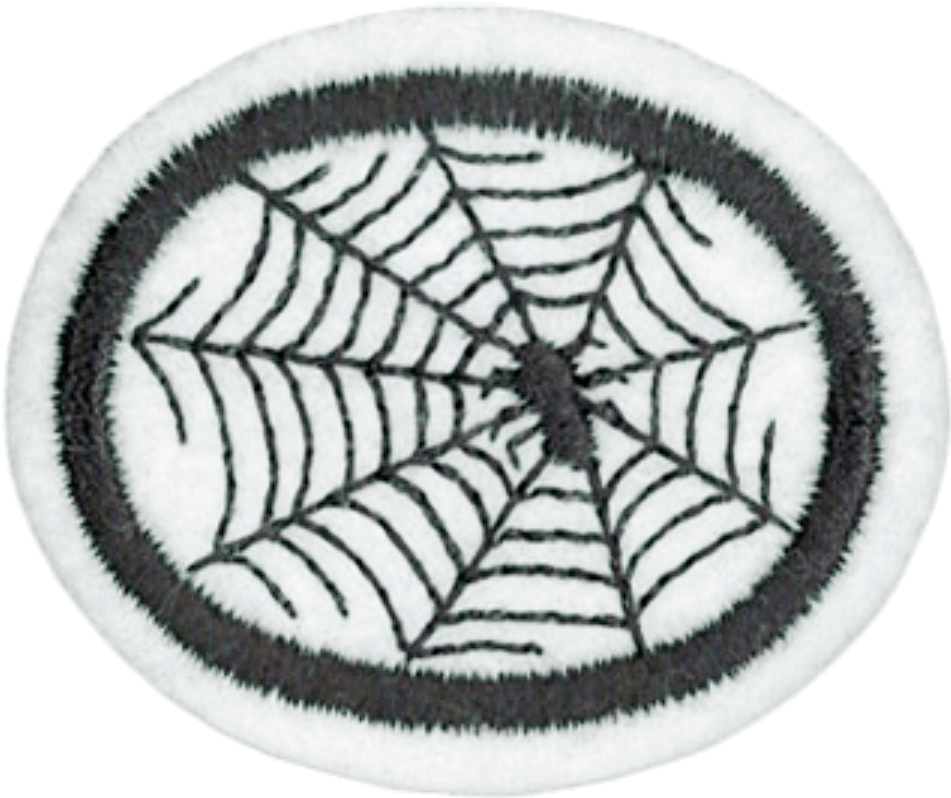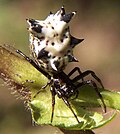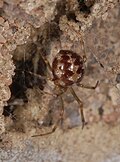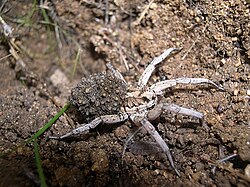Difference between revisions of "AY Honors/Spiders"
Jomegat bot (talk | contribs) m (Fix Tab Name transclusion) |
Jomegat bot (talk | contribs) (Convert honor_tab to honor_landing *** existing text overwritten ***) |
||
| Line 1: | Line 1: | ||
| − | |||
| − | |||
<translate> | <translate> | ||
| − | {{ | + | {{honor_landing |
|honorname=Spiders | |honorname=Spiders | ||
|skill=2 | |skill=2 | ||
| Line 9: | Line 7: | ||
|authority=General Conference | |authority=General Conference | ||
|insignia=Spiders_Honor.png | |insignia=Spiders_Honor.png | ||
| − | + | |overview= | |
| − | + | |challenge= | |
| − | |||
| − | |||
| − | |||
| − | |||
| − | |||
| − | |||
| − | |||
| − | |||
| − | |||
<b>{{reqreq|page={{PAGENAME}}|num=1}}</b> | <b>{{reqreq|page={{PAGENAME}}|num=1}}</b> | ||
:<b>{{reqreq|page={{PAGENAME}}|num=1a|dispreq=a.}}</b> | :<b>{{reqreq|page={{PAGENAME}}|num=1a|dispreq=a.}}</b> | ||
:<b>{{reqreq|page={{PAGENAME}}|num=1b|dispreq=b.}}</b> | :<b>{{reqreq|page={{PAGENAME}}|num=1b|dispreq=b.}}</b> | ||
:<b>{{reqreq|page={{PAGENAME}}|num=1c|dispreq=c.}}</b> | :<b>{{reqreq|page={{PAGENAME}}|num=1c|dispreq=c.}}</b> | ||
| − | + | }} | |
</translate> | </translate> | ||
| − | |||
| − | |||
| − | |||
| − | |||
| − | |||
| − | |||
| − | |||
| − | |||
| − | |||
| − | |||
| − | |||
| − | |||
| − | |||
| − | |||
| − | |||
| − | |||
| − | |||
| − | |||
| − | |||
| − | |||
| − | |||
| − | |||
| − | |||
| − | |||
| − | |||
| − | |||
Revision as of 01:25, 20 January 2021
The most challenging requirement of this honor is probably this:
1. Do one of the following:
- a. Collect, identify, and preserve at least 16 species of spiders. Place on each specimen bottle a label showing the locality and date of capture and the spider's common or scientific name.
- b. Make colored drawings or paintings of at least 16 species of spiders, life size or larger and in natural coloring. Label each with its common or scientific name.
- c. Take color photos of at least 16 species of spiders. Identify each picture as to its locality, date taken and the common or scientific name of the spider.
1. Do one of the following:
- a. Collect, identify, and preserve at least 16 species of spiders. Place on each specimen bottle a label showing the locality and date of capture and the spider's common or scientific name.
- b. Make colored drawings or paintings of at least 16 species of spiders, life size or larger and in natural coloring. Label each with its common or scientific name.
- c. Take color photos of at least 16 species of spiders. Identify each picture as to its locality, date taken and the common or scientific name of the spider.
2. What is the largest member of the spider family?
3. Write or give orally a description (forty words or more) of a spider that has gained notoriety in your region.
4. Give three ways in which spiders differ from insects.
5. Make a careful drawing of an orb web.
6. What other kinds of webs are there besides the orb web?
7. What do spiders eat? Make a list of victims found in spider webs.
8. For what is a spider web useful?
9. Find two references in the Bible to spiders and their webs.
10. What are the chief enemies of spiders?
11. How do spiders:
- a. Help us?
- b. Hurt us and our property?
1
Due to the fact that we now have many endangered species of spiders, you may want to encourage the selection of options b. or c.
http://www.umich.edu/~esupdate/library/97.03-04/skerl.html
1a
http://www.amonline.net.au/spiders/collections/collecting.htm gives instructions on how to safely capture spiders for identification. This site also lists other sites that will assist with identification of the captured spider.
1b
1c
http://www.byteland.org/spiderfest/index.html has a perpetual spider photo contest along with pointers on how to take photos of spiders. If your camera has a macro mode, be sure to use it when taking close-up photos. This feature is marked with a flower icon on many cameras. Most cameras cannot focus on close-up objects unless they are in the macro mode.
To identify the spiders you find, you may need to consult a field guide. If you wish to also earn the AY Honors/Insects/ honors, select one that covers both spiders and insects. You can also post photos of spiders at SpiderIdentification.org. The helpful community there will gladly attempt to make an identification for you.
2
The goliath bird eating spider (also called the birdeater) (Theraphosa blondi) is an arachnid belonging to the tarantula family and is the largest spider in the world. The spider was named by explorers from the Victorian era, who witnessed one eating a hummingbird and reported the sighting to the Western world.
The largest ever found had a leg-span of more than 28cm![]() .
.
3
The spider would depend on where you live. Use the suggested resources and your local library for books on spiders of your area. You may also wish to use an Internet search engine, and search for something like "notorious spider" and the name of your region, country, or continent.
4
Spiders have 8 legs while insects only have 6.
Spiders have singular eyes with lenses and insects have compound eyes.
Spiders don't have antennas and insects do.
Spiders have bodies with two parts: combined head and thorax called the cephalothorax, and the abdomen; insects have bodies with three body parts: head, thorax, and abdomen.
http://www.xs4all.nl/~ednieuw/Spiders/InfoNed/The_spider.html
http://www.explorit.org/science/spider.html
5
6
Funnel & Sheet webs spun by grass spiders, Family Agelenidae. The Sheet web is used to catch prey while the spider hides in the attached Funnel web for just the right time to scurry out to the helpless victim
Nursery Webs, used as a nursery or special nest carried around by the female until the eggs are about to hatch, spun by Family Pisauridae
Cobweb, irregular webs spun by comb-footed spiders, family Theridiidae
7
Here are some of the things that spiders eat. Accept all reasonable answers for the first question. Flies, Grasshoppers, Wasps, Bees, Mosquitoes, Geckos, Small lizards, Other Spiders, Insects, Snakes, Small Birds, Mice, Frogs, Small Fish, Tadpoles, Crickets, beetles, mealworms, cockroaches
Locate a web either at the location of the meeting or have each student watch one near their home. Write down what they see caught in the web.
8
- Cross hairs for optical instruments. (Gun sights, microscopes, telescope finder scopes)
- Birds use webs for constructing nests.
- Spider webs can be used to cover an injury and help the blood to clot.
- Scientists are experimenting with using spider webs in repairing torn human ligaments.
9
Here are three possibilities:
So are the paths of all that forget God; and the hypocrite’s hope shall perish:
Whose hope shall be cut off, and whose trust shall be a spider’s web.
He shall lean upon his house, but it shall not stand: he shall hold it fast, but it shall not endure.
There be four things which are little upon the earth, but they are exceeding wise:
The ants are a people not strong, yet they prepare their meat in the summer; The conies are but a feeble folk, yet make they their houses in the rocks; The locusts have no king, yet go they forth all of them by bands;
The spider taketh hold with her hands, and is in kings’ palaces.
Behold, the LORD’S hand is not shortened, that it cannot save; neither his ear heavy, that it cannot hear:
But your iniquities have separated between you and your God, and your sins have hid his face from you, that he will not hear. For your hands are defiled with blood, and your fingers with iniquity; your lips have spoken lies, your tongue hath muttered perverseness. None calleth for justice, nor any pleadeth for truth: they trust in vanity, and speak lies; they conceive mischief, and bring forth iniquity. They hatch cockatrice’ eggs, and weave the spider’s web: he that eateth of their eggs dieth, and that which is crushed breaketh out into a viper.
Their webs shall not become garments, neither shall they cover themselves with their works: their works are works of iniquity, and the act of violence is in their hands.
10
Due to excessive habitat destruction, man is the spider's worst enemy.
Round worms and mites are parasites that attach themselves to the spiders, sucking them dry of their vital fluids.
Birds enjoy tasty spider snacks, as do lizards, wasps, and other spiders.
Almost every small carnivore is the spider's enemy.
11
- Emphasize that even though there are some poisonous spiders, except for a few rare cases, they bite humans only in self-defense. The human race needs spiders in order to survive.
11a
Spiders are predators and so they eat flies and other small annoying insects. Many of these insects destroy our crops and gardens. Other insects caught in their webs can cause disease in humans.
Dust mites live in our homes and eat the dead skin that comes off our bodies. Many people are allergic to dust mites. Spiders eat the Dust Mites, thereby assisting in allergen control.
Spiders are an integral part of the food chain. Because the spider eats and is eaten, it helps to keep the ecosystem balanced. Without spiders the ecosystem would become imbalanced, seriously damaging many living things, including humans.
11b
Some spiders are venomous. Their bites can range from painful to deadly if the correct treatment is not used within a short time after the bite.
Most people are afraid of spiders, so if a property has either too many spiders or poisonous spiders, it would be hard to sell that property.
Spiders make webs in unwelcome places, like corners of rooms or between limbs of trees over a path. These webs cause us to spend time and money removing them. Their webs also trap dust that can cause an allergic reaction in some people.
References
http://www.cirrusimage.com/spider.htm
http://www.explorit.org/science/spider.html
http://www.everythingabout.net/articles/biology/animals/arthropods/arachnids/spiders/index.shtml
http://www.ezprezzo.com/crazypics/spider_eats_snake.html
http://cybersleuth-kids.com/sleuth/Science/Animals/Arachnids/Spiders/index1.htm
http://sciencebulletins.amnh.org/biobulletin/biobulletin/story991.html
About the Author
Stephanie East
Educator with a Master's in Education with an Outdoor Education emphasis
Elementary, Middle School & High School Teacher
Corporate Computer Trainer
Co-Director of Wilderness Adventure Camp for the Illinois Conference of Seventh-day Adventists
Co-Creator with Rodney East of "Why Knot? an introduction to knots, splices & rope" DVD which has all the information needed to complete the Knot Tying Honor. Available through Advent Source.
Content on this wiki is generated by people like you, and no one has created a lesson plan for this honor yet. You could do that and make the world a better place.
See AY Honors/Model Lesson Plan if you need ideas for creating one.





















